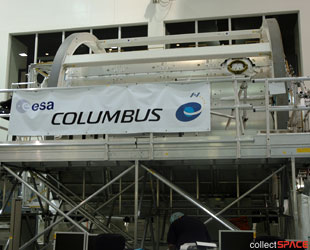Now orbiting at 140 miles above Earth, Atlantis is set to dock with the space station on Saturday, February 9. Once there, the STS-122 crew will start moving supplies, equipment and a crew member to the outpost.
Stowed aboard Atlantis, among its secondary payloads, are three NASCAR green race flags, which are being flown to mark the 50th anniversary of the Daytona 500.
The mission's primary purpose is the installation of the Columbus laboratory. The cornerstone of the European Space Agency's contribution to the ISS, Columbus is the first European-built module dedicated to long duration research in space.
The 23-foot cylindrical lab named after the explorer from Genoa builds upon the heritage of ESA's earlier research module, Spacelab, which flew on the space shuttle for the first time 24 years ago this month.
"Europe designed and built [Spacelab] pretty much the same dimension as Columbus, in length and in diameter, of course, because it had to fit in the payload bay of the shuttle and we flew missions up to, I think, 14, or was it 16 days in the longest Spacelab mission on the shuttle and it worked fine," explained STS-122 mission specialist and ESA astronaut Hans Schlegel in an interview with collectSPACE.com. "More than 20 times it flew in space and we did research in it."
This, his second flight to space, Schlegel's first mission was nearly 15 year ago with the second German-funded Spacelab payload.
"We worked 98 experiments within 10 days out of 11 scientific disciplines," he recalled of the Spacelab D-2 flight on STS-55. "Great capability, and Columbus is just the follow-up to that. It is a highly sophisticated scientific laboratory. It will give [the] space station, I would say, almost the same capability as it has right now, on top of that."

| The European Space Agency's Columbus laboratory inside NASA's space station processing facility. Click to enlarge. |
Although it is the station's smallest laboratory module, Columbus offers the same payload volume, power, and data retrieval, for example, as the station's other labs. It was launched outfitted with 5,511 pounds of experiment facilities and additional hardware.
During STS-122, Schlegel will perform a spacewalk with NASA astronaut Rex Walheim to configure Columbus for installation on the station.
"It's a joy for me to bring up Columbus," said Schlegel.
In addition to the new lab, Schlegel also accompanied another European station contribution to space: Léopold Eyharts.

| The crew of STS-122 pauses before boarding the AstroVan and riding to launch pad 39A. Click to enlarge. |
Seated with Schlegel on Atlantis' middeck for the ride to orbit, Eyharts will become part of the station's Expedition 16 crew soon after arriving. He replaces U.S. astronaut Dan Tani, who will return to Earth in Eyhart's seat on the space shuttle. Eyharts was originally scheduled to reside on the ISS for three months, but due to the launch delay, will be there for just over one month as he continues the configuration of Columbus.
Positioned between the two European astronauts aboard Atlantis is the 300th American to enter space, but only by a few inches. The 301st and 302nd astronauts were quick to follow him by less than a second.
"I think if you look at the shuttle, [Stan Love is] the first one in space," said STS-122 pilot Alan Poindexter in an interview with collectSPACE. "Stan is on the middeck and I think the middeck seats are actually slightly forward of the pilot seat. I think when you go up to the flight deck, you are actually, maybe a little aft of the forward middeck seats," explained Poindexter, who like Love is making his first flight.
Not that Love is enamored with the title.
"If you're the first, it's a big deal. If you're the 300th or the 301st, to me it's no difference," said Love.
Poindexter agreed. "It's a unique novelty but it doesn't mean much. What it means is that there have been 300 Americans in space and someday, hopefully, it will be 3,000. We would really like to have more people in space. That's what we're after, right?"
Mission specialist Leland Melvin, a former NFL football player, is the third on the crew that was eligible for the record. He is seated on the flight deck behind Poindexter.
"When I look back on the people that have paved the way, the Gemini, the Apollo, the Mercury programs, the Skylab and all these programs, they have passed on this lineage and this heritage to us. In turn, I hope that I can do the same for the next explorers that will help inspire this next generation of explorers. It's an honor if I were to go down as the 300th [American] in space," Melvin said.
Today's launch began NASA's first shuttle mission of the year and its 24th to the space station. It marked the 29th liftoff of Atlantis, and the 121st in shuttle program history.
Columbus' mission aboard Atlantis began seven years to the day after the launch of the U.S. science lab, Destiny, which was also delivered to the space station by Atlantis.
